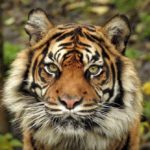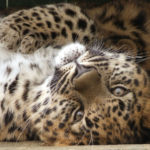Rangers across the world protect 15% of the planet’s land mass covering a huge diversity of ecosystems including mountains, forests, tundras and wetlands. Join us in celebrating them this World Ranger Day!
This World Ranger Day we are holding space for rangers who have lost their lives or been injured in the line of duty. We also want to celebrate the work the numerous rangers do on the projects we fund across Asia. These rangers are essential frontline conservation workers and the first line of defence in protected areas that wild tigers and Amur leopards call home. They are guardians of the wild, as well as teachers, firefighters, wildlife wardens, guides, scientific collaborators, emergency responders and so much more.
The rangers we support come from various backgrounds, from big cities to small villages and Indigenous communities. However, one thing they have in common is their determination to protect Asia’s remaining wild spaces. Here, we spotlight some of these exceptional individuals and bring you closer to the people securing our natural spaces.
Meet the rangers

Name: Valentin O. Arshinov
Age: 31
Location: Annuiski National Park, Khabarovsk Province, Russian Far East
What is the best thing about your work?
Communicating with nature. Learning new things about flora and fauna. With great pleasure, to accompany scientific workers to the territory of Anyuisky National Park.
What part of your work seems the most difficult to you?
Being away from home. Unexpected equipment breakdowns during raids. Challenging weather conditions.
What are your hopes for the future for the landscape and the species you help protect?
Preserving natural ecosystems in their natural state for the next generation. To preserve the diversity of fauna of the Far Eastern taiga, including the Amur tiger and other red-listed species inhabiting Nanaysky District, like the forest cat, the soft-skinned turtle, and many bird species, like the scaly-sided merganser, Blakiston’s fish owl and others.
I hope that our descendants will gratefully remember my contribution to environmental protection.

Name: Liu Guoqing
Age: 32
Location: WCS China, Hunchun
What is the best thing about your job?
As a ranger, my work scope includes anti-poaching patrol, wildlife monitoring, field investigation and related publicity and education. Among them, my outstanding work is publicity and education, which is mainly reflected in the alleviation of “human-animal conflict”. At present, I am responsible for joint community anti-poaching projects and promoting the “community co-management” model. I am also constantly exploring ways to integrate conservation work with people’s livelihood.
What part of your job do you find the most difficult?
I think solving the “human-animal conflict” problem is the difficult part of the job. The overall connectivity of habitat plays a crucial role in the dispersal of tiger and leopard populations to inland China. With the expansion of wild tiger and Amur leopard habitat in northeast China, the production and life of local residents have been threatened and damaged. I personally believe that alleviating the problem of “human-animal conflict” will be a difficult task for the conservation of wild tigers and Amur leopards.
What are your hopes for the future for the landscape and species you help to protect?
I hope that the population of wild tigers and leopards in China can be better restored, the habitat can be connected, and the ecological environment can be better protected. At the same time, I also hope that people living near the habitat of tigers and leopards can live and work in peace, and the problem of “human-animal conflict” can be solved.

Name: Mikhail P. Melishik
Age: 29
Location: BolsheKhekhtsirski Nature Reserve, Khabarovski Province, Russian Far East
What is the best thing about your job?
The opportunity to be closer to nature; to enjoy my work; to feel that you are doing a really necessary thing in the protection of the environment and the reserve.
What part of your job do you find the most difficult?
The lack of qualified state inspectors, insufficient technical equipment for inspectors, small salaries of state inspectors and difficulties with official housing.
What are your hopes for the future for the landscape and species you help to protect?
In the future, I would like to develop tourism infrastructure within the reserve and improve the technical equipment for inspectors to improve the protection of the reserve.

Name: นาย เอนก ศรีสุพรรณ /Anek Srisuphan
Age: 49
Location: Khao Laem National Park Kanchanaburi, Thailand.
What is the best thing about your job?
Working as a ranger and protecting nature is the thing I love the most. And more than that it is a job that gives me a salary and a life.
What part of your job do you find the most difficult?
Encroachment is the biggest problem as it is difficult to monitor. Resolving this means careful coordination to create a better understanding between the officials and the local community.
What are your hopes for the future for the landscape and species you help to protect?
Promoting participation between parks and communities to take better care of forests to reduce over-exploitation of natural resources and to better conserve forests so that nature can rebound. To foster a better awareness about community use of water resources and to gain their support to reduce forest fires.
I would like to see better welfare of officials, such as life insurance or help with medical expenses including an improved salary as we are paid poorly.

Name: นาย พรชัย ไทรสังขละกุลพร /
Pornchai Saisangkhlakulporn
Age: 35
Location: Khao Laem National Park Kanchanaburi, Thailand
What is the best thing about your job?
I love my job and have so many new experiences. I enjoy the camaraderie of being part of a patrol team protecting the forest.
What part of your job do you find the most difficult?
Working in remote areas without communications, especially in risky areas prone to dangerous conditions, such as flash floods.
What are your hopes for the future for the landscape and species you help to protect?
I would like to see improved protection for wildlife and nature to facilitate population recovery. To do this we need an increase in resources for protection and law enforcement so we can adequately patrol. My goal and hopes are that we can keep healthy forests for our children to see and experience in the future.



